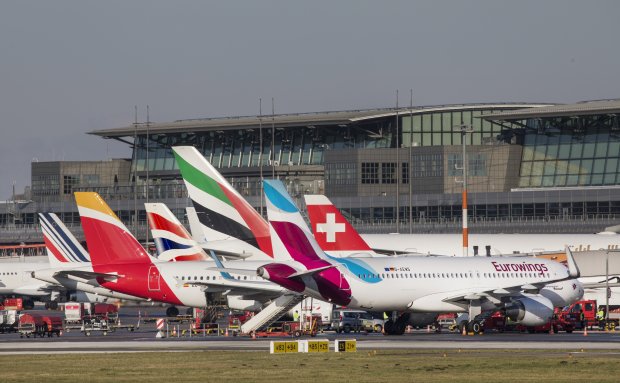Hamburg Airport takes stock of 2017: a demanding and successful year

Increased revenue despite rising costs / Above-average passenger growth / Outlook for 2018: stabilisation with fewer aircraft movements
Hamburg Airport today took stock of 2017, and the view was positive. The year was characterised by a healthy commercial result and by strong passenger growth. There continues to be great variety in the route network, and the airport has increased service and comfort levels for passengers as well as enhancing the Hamburg touch, with innovations such as the Hamburg Welcome Center, redesigned waiting areas and the flexible Self Bag Drop baggage kiosks. With its optimised infrastructure, Hamburg Airport is preparing for the future demands of air traffic and the growing demand for mobility.
“2017 was a demanding and a successful year, and we mastered the challenge well,” reflects Michael Eggenschwiler, CEO of Hamburg Airport. “In line with our mission of ensuring mobility in northern Germany, we will offer more than 17.5 million passengers an optimal travel experience in 2018. We will continue to develop Hamburg Airport, step by step. We will already have all the jetbridges back in operation this coming summer, so that we can ensure short walking distances and comfortable travel for our passengers. Hamburg continues to be an attractive market, and this enables us to maintain the great variety in the route network we offer to the people of northern Germany.”
Strong growth results in revenue growth
Hamburg Airport finished the 2017 financial year positively. The airport achieved a positive final result of 46.6 million euros despite increased costs in, for example, the areas of personnel, maintenance and IT. The figure for 2016 was 48.1 million euros. Turnover was 264.5 million euros, up from 244.1 million euros in 2016. The airport’s investment volume in 2017 amounted to 88.2 million euros (2016: 100.8 million euros). The biggest investment projects were the 2017 construction phases of the comprehensive Apron 1 refurbishment along with the ground handling and administrative authorities building. These investments result in a 9.4 percent increase in the balance sheet total to 599.4 million euros (2016: 548.1 million euros).
Passenger numbers rise as aircraft movements decrease
More and more northern Germans are travelling by plane. 17.62 million passengers used Hamburg Airport in 2017. This is 1.4 million passengers, or 8.6 percent, more than in 2016. This was the first time that there were more than 17 million passengers in one year in the history of the airport. Aircraft movements, totalling 159,780 in 2017, were fewer than in the year 2000, when just under 10 million passengers used Hamburg Airport. Compared to 2016, the number of aircraft movements declined by around 0.5 percent.
A glance at the passenger load factor shows just how efficient air travel is becoming. The average number of passengers per flight in 2017 was 121.4, compared to an average of 112.4 in 2016. The average number of seats per flight has increased from 147 to 156. The load factor on flights to and from Hamburg Airport rose by 1.2 percentage points to 77.8 percent in comparison to 2016.
2018 summer timetable: European metropoles and holiday destinations
The 2018 summer timetable, which came into effect on 25 March, has seen Hamburg Airport’s route network grow further with attractive new routes. There are eight completely new destinations: Bilbao, Jersey, Samos, Ljubljana, Kayseri, Zakynthos, Trieste and Bergen, with two airlines serving the latter in the high season. Service is being expanded by additional airlines serving another eight routes: Corfu, Munich, Edinburgh, Oslo-Torp, Fuerteventura, Tenerife, Gran Canaria and Bodrum. A total of around 60 airlines are flying to approximately 130 destinations in Hamburg’s 2018 summer timetable. More than 1,000 destinations can be reached from Hamburg with just one connecting flight.
Outlook for 2018: stabilisation is expected
“We have deliberately planned conservatively for 2018, because the airlines are still on a consolidation path,” says Michael Eggenschwiler. “We expect passenger figures to remain stable at a high level, and a tendency to fewer aircraft movements. This summer, we will be launching eight completely new routes, so that one thing remains constant for our passengers: a broad range from which to choose. Passengers will continue to have the choice between numerous airlines with different service levels and a large route network.”
Step by step, Hamburg Airport is optimising its terminals and aprons so as to be well equipped for the future demands of air traffic operations and for northern Germany’s ever-growing need for mobility. Phase 5 of the comprehensive refurbishment of the main apron commenced in February; this marks the halfway stage of the 120-million-euro project, scheduled for completion in 2020. During the first quarter of 2018, the baggage conveyor belts in the Terminal 2 zone have been replaced, too, and more space has been created in front of the central security checkpoint. In addition, this year will see construction work on the so-called Southern Passenger Pier begin. Six new jetbridges will be installed there, allowing for comfortable boarding direct from the building into the plane, and there will be a modern shopping area. Meanwhile, construction of shuttlebus gates will start on Apron 2 in 2018, as an interim replacement for the gates that will not be available during construction work on the terminals.


